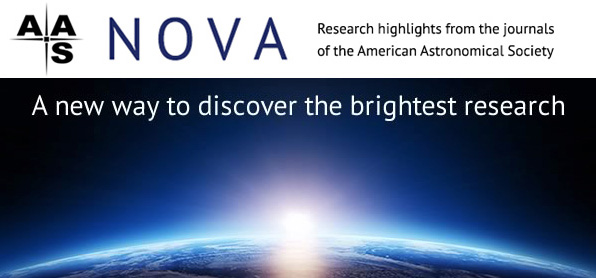Highlights from AAS Nova: 25 December 2016 - 9 January 2017

Susanna Kohler American Astronomical Society (AAS)
AAS Nova provides brief highlights of recently published articles from the AAS journals, i.e., The Astronomical Journal (AJ) and The Astrophysical Journal (ApJ), ApJ Letters, and ApJ Supplements. The website's intent is to gain broader exposure for AAS authors and to provide astronomy researchers and enthusiasts with summaries of recent, interesting research across a wide range of astronomical fields.
The following are the AAS Nova highlights from the past two weeks; follow the links to read more, or visit the AAS Nova webpage for more posts.
9 January 2017
AAS 229: Day 4
This week we’re at the winter AAS meeting in Grapevine, TX. Here are the highlights from Day 4!
7 January 2017
AAS 229: Day 3
This week we’re at the winter AAS meeting in Grapevine, TX. Here are the highlights from Day 3!
6 January 2017
AAS 229: Day 2
This week we’re at the winter AAS meeting in Grapevine, TX. Here are the highlights from Day 2!
5 January 2017
AAS 229: Day 1
This week we’re at the winter AAS meeting in Grapevine, TX. Here are the highlights from Day 1!
3 January 2017
AAS 229: Welcome!
This week we’ll be bringing you updates from the 229th AAS meeting in Grapevine, TX.
30 December 2016
Selections from 2016: Hidden Galaxies Found Behind the Milky Way
Hundreds of new galaxies were discovered this year hiding behind the Milky Way in the “Zone of Avoidance”.
29 December 2016
Selections from 2016: A Connection Between Solar Explosions and Dimming on the Sun
A study of a solar explosion has revealed a link between the ejection of plasma from the Sun’s surface and dimming of its corona.
28 December 2016
Selections from 2016: A Very Dark Galaxy
This year, scientists discovered Dragonfly 44, a faint galaxy whose center is made up of a whopping 98% dark matter.
27 December 2016
Selections from 2016: Primordial Black Holes as Dark Matter
Could dark matter be made up of many black holes formed in the early universe? A study from this year examined this possibility.


